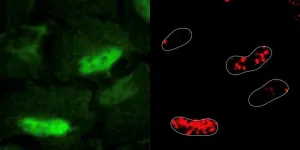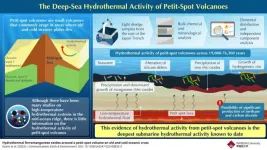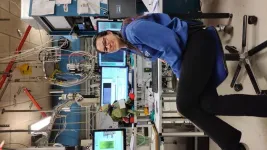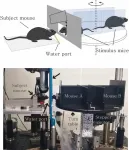(Press-News.org) PULLMAN, Wash. — Tick season is here, along with the increased danger of Lyme disease, and it turns out the tiny arachnids are even tougher than scientists previously thought.
A recent study in Ecological Monographs shows blacklegged ticks (Ixodes scapularis) are actually really good at surviving extreme cold and heat in nature. Previous lab research suggests that even short periods of especially warm or cold conditions should easily kill ticks, but the Washington State University-led analysis reveals this is only the case for larval ticks in the environment. Instead, nymph and adult ticks weather the hot and cold times with little impact, dying when they apparently run out of energy. The findings could ultimately provide valuable insights into the spread of Lyme disease and other vector-borne pathogens.
“We thought we would see some evidence that if there was like a very dry period, all the ticks might be at a greater risk of dying,” said Jesse Brunner, lead author of the study and an associate professor of biological sciences at WSU. “However, just the larvae were impacted by heat and dry conditions. Cold weather had even less of an impact. Somehow, they hunker down and survive great.”
Blacklegged ticks are notorious carriers of pathogens responsible for various diseases, including Lyme disease, which is the most common vector-borne illness in North America. Over the years, these ticks have expanded their range significantly across the Eastern United States and Midwest, challenging previous assumptions about their preferred habitats. While one of the culprits is likely climate change, scientists have yet to clearly establish why ticks are abundant in some areas while rare in others.
To address the knowledge gap, the U.S. Department of Defense provided funding to Brunner and a team of collaborators from the Cary Institute of Ecosystem Studies to set up an unprecedently large field study at three military bases located across the U.S. East Coast. By placing more than 9,000 ticks in soil core enclosures and monitoring their survival and development over a three-year period, the researchers were able to collect valuable data on the ticks’ response to climatic conditions.
Their work suggests that while extreme weather conditions don’t seem to have as much of an effect on tick mortality as previously thought, it does make them burn through their food faster. This means that hotter weather could shorten the window of time for ticks to find a host walking by to feed on. This was especially true in the case of tick larvae. The researchers found their median survival times were almost cut in half when exposed to frequent periods of hot and dry weather.
The researchers also found something else seemed to be happening on a small scale that was killing ticks. Soil core enclosures located just a few meters apart from each other often had surprisingly different rates of tick mortality. In one container the researchers would find 80% of the ticks had survived and in another right next to it none of the ticks had survived. The cause of these significant variations in tick survival is unclear, but the study’s findings suggest the influence of environmental factors such as arthropods or fungi.
The implications of the research are far-reaching, considering the public health impact of tickborne diseases. The study’s findings emphasize the importance of targeting interventions during the larvae stage, when ticks are the most vulnerable. By focusing on this stage of development, researchers hope to develop effective strategies, such as vaccinating host species to resist ticks, that can significantly reduce tick populations and mitigate the risk of disease transmission.
Moving forward, the research team plans to investigate the factors leading to localized tick mortality and delve deeper into the role host species, such as mice, deer and yes, humans, play in tick survival.
“The ultimate goal is to develop a comprehensive framework that can predict and effectively manage tick populations,” Brunner said. “This could in turn lead to improved public health outcomes.”
In addition to Brunner, the research was conducted by Cary Institute of Ecosystem Studies scientists Shannon LaDeau, Mary Killilea, Elizabeth Valentine, Megan Schierer and Richard Ostfeld.
END
Ticks prove resilient to extreme temperatures
2023-06-01
ELSE PRESS RELEASES FROM THIS DATE:
Integrating robotics into wildlife conservation: enhancing predator deterrents through innovative movement strategies
2023-06-01
The coexistence of wildlife and agricultural practices has long posed challenges for wildlife conservation, especially when conflicts arise. Livestock predation is a prime example of such conflicts, requiring effective management strategies that minimize human-wildlife conflict while preserving valuable agricultural resources. A new study published in PeerJ Life & Environment, titled "Integrating Robotics into Wildlife Conservation: Testing Improvements to Predator Deterrents through Movement," explores the integration of robotics and agricultural ...
BU researchers identify several new genetic risk factors for Alzheimer’s disease unique to Ashkenazi Jews
2023-06-01
EMBARGOED by Alzheimer's & Dementia: The Journal of the Alzheimer's Association, until June 1, 2023, 7 a.m., ET.
Contact: Gina DiGravio, 617-358-7838, ginad@bu.edu
(Boston)—Alzheimer disease (AD), the most common neurodegenerative disorder in the world, affects individuals of all races and ethnicities; however, most genetic research for AD has been performed on individuals of European ancestry (EA) with a limited number of large-scale genetic studies in other populations.
For many centuries, Ashkenazi Jews lived in communities in Eastern Europe and were genetically isolated from their non-Jewish neighbors. As a result, ...
DNA damage repaired by antioxidant enzymes
2023-06-01
In crisis, the nucleus calls antioxidant enzymes to the rescue. The nucleus being metabolically active is a profound paradigm shift with implications for cancer research.
Summary points
The human nucleus is metabolically active, according to the findings of a new study in Molecular Systems Biology by researchers at the CRG in Barcelona and CeMM/Medical University of Vienna,
In a state of crisis, such as widespread DNA damage, the nucleus protects itself by appropriates mitochondrial machinery to carry out urgent repairs that threaten the genome’s integrity
The ...
Petit-spot volcanoes involve the deepest known submarine hydrothermal activity, possibly release CO2 and methane
2023-06-01
Underwater volcanism on the Earth's crust are active contributors of many different elements to the oceanic environment. Hence, they play an important role in biogeochemical and chemosynthetic cycles of the ocean. Although there have been many studies on high-temperature hydrothermal systems in the mid-ocean ridge—a series of underwater volcanoes that trace the edges of the different oceanic plates—there is little information on low-temperature hydrothermal systems in other volcanoes, such as "petit-spot" volcanoes.
Petit-spot volcanoes are small volcanoes ...
Producing large, clean 2D materials made easy: just KISS
2023-06-01
Ever since the discovery of the two-dimensional form of graphite (called graphene) almost twenty years ago, interest in 2D materials with their special physical properties has skyrocketed. Famously, graphene was produced by exfoliating bulk graphite using sticky tape. Although it was good enough for a Nobel Prize, this method has its drawbacks. An international team of surface scientists has now developed a simple method to produce large and very clean 2D samples from a range of materials using three different substrates. Their method, kinetic in situ single-layer synthesis (KISS) ...
House of moveable wooden walls unveiled, promising a cheaper, greener alternative to ‘knocking through’.
2023-06-01
University of Cambridge architects are inviting visitors to the London Design Biennale to experience a prototype home constructed with flexible wooden partition walls which can be shifted to meet the changing needs of residents. The invention aims to reduce waste and carbon while also improving living conditions for those who cannot afford expensive refurbishments.
[Images will be available to download here from 10AM (UK Time) on 1st June]
House-owners the world over consider ‘knocking through’ walls to achieve more open-plan living or changing layouts to accommodate new arrivals or circumstances. ...
Biodegradable plastic from sugar cane also threatens the environment
2023-06-01
Plastic made from cane sugar also threatens the environment. Researchers from the University of Gothenburg have found that perch change their behaviour when exposed to so-called bioplastic.
Traditional plastic, based on fossil oil, has flooded the earth and there is microplastic in all living things. This has led to intensive research for alternatives that decompose faster in nature. Bio-based polymers based on cane sugar are one such option. The most common bioplastic is poly-L-lactide (PLA), which is used in 3D printers, textiles, food packaging, disposable cutlery and other applications.
PLA plastic changed the behaviour of perch
Bioplastics also have a negative impact on biological ...
Finally solved! The great mystery of quantized vortex motion
2023-06-01
Liquid helium-4, which is in a superfluid state at cryogenic temperatures close to absolute zero (-273°C), has a special vortex called a quantized vortex that originates from quantum mechanical effects. When the temperature is relatively high, the normal fluid exists simultaneously in the superfluid helium, and when the quantized vortex is in motion, mutual friction occurs between it and the normal-fluid. However, it is difficult to explain precisely how a quantized vortex interacts with a normal-fluid in motion. Although several theoretical models have been proposed, it has not been clear which model is correct.
A research group led by Professor Makoto Tsubota and Specially ...
Q&A: Virginia Tech researchers discover new, more effective candidates for treatment of syphilis
2023-06-01
Since 2000, sexually transmitted infection rates have been on the rise. Syphilis, a disease that was nearly eradicated in the United States at that time, now affects more than 18 million people worldwide each year with few options for effective treatment.
One challenge that has plagued syphilis researchers for decades was the inability to culture and study the disease-causing agent in a laboratory setting.
“The incredible efforts of our colleagues and collaborators produced a faithful system to propagate the disease-causing agent in vitro, or in a laboratory setting. Being able to culture ...
Discovery of neurons that recognize others
2023-06-01
Researchers from the Center for Cognition and Sociality (CCS) within the Institute for Basic Science (IBS) recently announced the discovery of neurons that allow us to recognize others. The research team discovered that the neurons that deal with the information associated with different individuals are located in the CA1 region of the hippocampus.
Social animals, including humans, constantly engage in interactions with others. In this process, the ability to recognize the identity of the social counterpart, retrieve relevant information about them from memory, ...






